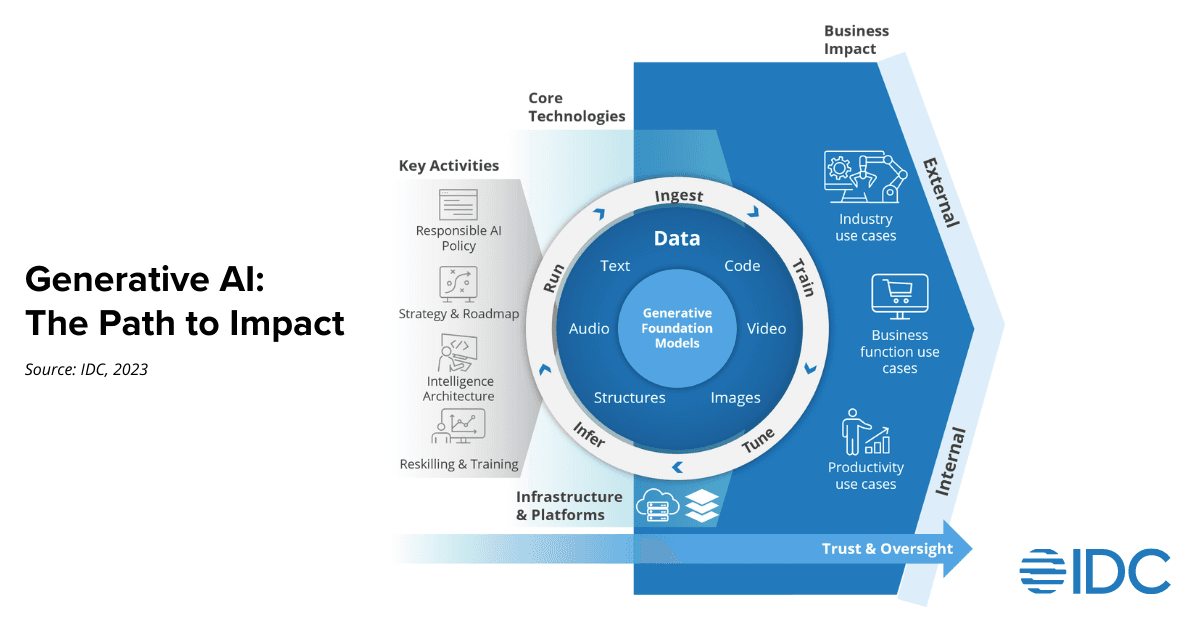Diving into the Realm of Generative AI
The dynamics of the business sphere are undergoing a seismic transformation, all thanks to the surge of Generative AI (Gen-AI). This transformative shift not only stems from the direct influence of Gen-AI but also from its role in emphasizing the significance of AI at large, thus elevating its prominence in the business domain. This transformation is as monumental as the revolutions brought by personal computers in the 1980s and smartphones in the 2000s. The potential to reshape industries, fuel innovation, optimize operations, reshape workforces, unlock the potential of knowledge management, and democratize AI is simply astounding.

To harness this potential, organizations should navigate this evolution with a systematic, deliberate, and thoughtful approach. This doesn't imply that the process should be sluggish; instead, it requires careful consideration to ensure responsible implementation and tangible, scalable outcomes. Achieving this goal entails a close partnership between technology and business leaders, working together to swiftly identify and execute short-term projects while keeping long-term objectives in sight.
Laying the Groundwork for Success
Prior to embarking on the quest to harness the capabilities of Gen-AI, organizations need to establish a strong foundation. This foundation encompasses several vital components:
1. Ethical AI Guidelines
A well-defined AI policy, outlining principles of fairness, transparency, accountability, and data protection, is of utmost importance. Ensuring that AI model outputs are explainable and adhering to legal and regulatory mandates such as GDPR are the basic prerequisites.
2. Crafting an AI Vision and Roadmap, and the Role of Initial Testing
Creating a comprehensive AI strategy that prioritizes use cases is vital for aligning organizational efforts with short-term and long-term business impact.
The AI strategy should encompass guidelines for initial Gen-AI proof of concepts (POCs), and it should integrate insights from these POCs to continually enhance the strategy. This adaptive approach ensures the strategy's effectiveness over the long haul, fostering agile decision-making.
Large-scale, transformative Gen-AI projects might be a leap for many organizations due to skills, policies, and data limitations. Through focused POCs, organizations can swiftly identify gaps in skills, data, policies, and technology. These POCs enable quick assessment of technology feasibility without significant investment.
When selecting POCs, consider the following criteria:
- Value: Economic value, strategic alignment, risk assessment
- Complexity: Data requirements, algorithm intricacy, system demands, essential skills
For instance, if a proposal boasts high value but lacks reliable data, it might not be suitable for a POC. Similarly, projects with both high value and quality data but substantial risk might be more suitable after building experience.
Organizations should avoid excessive planning that leads to delays in piloting this transformative technology.
3. Architecting Intelligent Systems
While Gen-AI POCs may not necessitate an entire platform for enterprise-wide initiatives, their selection criteria should consider how they contribute to understanding the platform's necessary elements. The architecture must address platform implementation, governance, data models (structured, evaluated, integrated), and integration with existing systems.
The architecture should seamlessly embed data privacy, security, and intellectual property protection.
4. Upskilling and Training
Most organizations lack the mature skillsets required for optimal utilization of Gen-AI, including prompt engineering, data science, AI ethics, and modelling. Equipping the workforce with the skills needed to build and utilize Gen-AI models is imperative. This may involve hiring new talent or reskilling current staff.
Broad training should be extended across the organization to create a foundational understanding of the technology's benefits and risks due to its potential business impact.
Implementing readiness assessment programs helps ensure a smooth transition, enhancing comprehension of the technology's implications on staffing, organizational dynamics, and cultural inertia. Addressing staff concerns proactively fosters a positive reception of the technology.
5. Data's Central Role
Data serves as the bedrock of Gen-AI. However, most organizations struggle with data management. Despite leaders claiming that data is their most valuable asset, its curation, management, comprehension, and analysis are frequently subpar. A survey by Dan & Bradstreet1 revealed concerning results about data quality among organizations:
- 80% of companies report high or moderate degree of data silos
- 66% experience some degree of shadow (or rogue) data depositories
- 69% are unable to provide a comprehensive, single customer view
When assessing POCs for selection, prioritize data quality, ease of retrieval, and integration. Select those POCs that can leverage shared quality datasets over those requiring management of disparate data. The strategic leverage of Gen-AI is challenging enough; additional complexity from disparate data should be avoided (at least initially).
Security Imperatives
Maintaining high-quality, accurate, and secure data is non-negotiable for many enterprises. The integrity and privacy of training data directly affect AI model performance. Contaminated data can lead to inaccurate models that will fail to deliver desired outcomes. Addressing data quality, accuracy, and security is paramount.
Influence on Infrastructure and Software Platforms
The adoption of Gen-AI brings implications for infrastructure and software platforms. Decisions on investment must consider whether to fund via as-a-service models or traditional capital investments. Security, compliance, and risk tolerance will also come into consideration. POCs play a crucial role in shaping these investment decisions.
Software development cycles will accelerate, and low-code/no-code programming efforts will diversify coding across AI-optimized architectures. This transformation necessitates flexible, API-enabled environments that balance security, performance, cost-effectiveness, portability, and resilience.
Defining and Prioritizing Usage Scenarios
Usage scenarios play a pivotal role in driving the impact of Gen-AI and shaping the overall strategy. Scenarios often fall into these categories:
1. Industry-Specific: Tailored solutions like drug discovery or material design demand customization and specialized data sharing. While they generate significant value, they require distinct models and integration, posing risks and challenges.
2. Business Functions: Integrating models with department-specific data (e.g., marketing, sales, procurement) requires meticulous data governance and integration with established enterprise systems.
3. Productivity: Foundational use cases encompass summarization, code generation, and template creation. These often integrate into existing applications as standalone solutions or cloud-based APIs. Gen-AI can expedite the meta-tagging and categorization of enterprise data, enhancing data quality and retrieval. Additionally, Gen-AI automates knowledge management by synthesizing diverse data sources, revolutionizing traditional approaches.
Engage C-suite executives and key leaders in collaborative sessions to identify relevant use cases and formulate a pragmatic roadmap. Create a mechanism to capture ideas emerging from various divisions or business lines.
Strategic Partner Selection: A Thoughtful Approach
In the swiftly evolving landscape of Gen-AI, clarity around the technology and its applicability is vital. Amidst this ambiguity, certain insights have emerged, particularly concerning the use of publicly shared foundation models and the role of cloud platform providers.
Cloud providers offer publicly shared foundation models, often as PaaS or SaaS, catering to specific enterprise use cases. Although they yield short-term advantages, they are commoditized and fail to provide long-term competitive edge. For lasting benefits, organizations should leverage finely-tuned, domain-specific models accessible privately—a prime example being Microsoft's investment in Gen-AI, positioning itself as a formidable player.
IT consultants and system integrators as robust contenders. They guide organizations through the intricate process of Gen-AI implementation; however, organizations should determine the duration and extent of reliance on these partners. The partners can help provide the initial momentum by providing skills that are scarce within enterprises. However, for sustained benefits, developing these skills internally often proves more advantageous in the long run.
Conclusion
Successfully navigating the realm of Gen-AI mandates a multifaceted approach encompassing ethical policies, sound data practices, technological acumen, a holistic view of use cases, and collaboration between IT and business leadership. Develop POCs with the aim of establishing and refining Gen-AI strategy and buckle up for an exhilarating journey!










